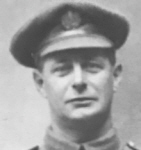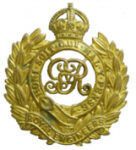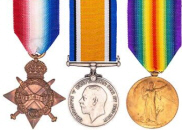



No.113222, Sergeant, Charles Harold HONESS
Aged 38

|
Charles Harold HONESS was born on 26th November 1879 in Kennington, London (Lambeth Q4-1879 1D:476), son of Ebenezer James and Sarah Ann HONESS (née HIDE). 1881 census...Aged 1, he was at 6 Lidford Terrace, Lots Road, Chelsea with his father Ebenezer J. HONESS [36] carpenter/blind maker born Rochester; his mother Sarah A. [35] born London; sister Annie C [6] born Chelsea, brothers Bertie S [5] born Chelsea; Ernest H [4] and Arthur [2] both born Lambeth. He was entered for St Margaret's Technical Day School and Westminster City School (Day School) on 12th March 1890, aged 9 and living at 8 Harwood Terrace SW. The hand written admission entry has his year of birth erroneously as 1889 1891 census...Aged 11, he was at Harwood Terrace, Fulham with his parents; brothers Bertie (errand boy), Ernest (both now recorded, as with Charles, as born in Kennington), Frederick [8] and sister Minnie N [4] both born in Chelsea. 1901 census...He was a teacher, (single ?) at the East Anglian School, Bury St.Edmunds. His parents were at 40 Elthiron Road, Fulham with his sisters Annie and Minnie; brothers Bertie (commercial traveller), Ernest (book keeper), Arthur (carpenter) and Frederick (book keeper) 1911 census...Aged 31, single (?), a teacher, he was at the East Anglian School, Bury St.Edmunds. His wife and four children; Violet May [11], Cyril Stewart [9], Harold [8] and Leslie Percy [6] ( all born in Palmers Green) were at 434 Kingston Road, Bushey Mead, Wimbledon His parents were at 175 New King's Road, Fulham (father now confectioner/tobacconist) with his brother Arthur (carpenter/joiner) and sister Minnie On September 7th 1899, an assistant school teacher at the time, living at 40 Elthiron Road, Fulham with his parents, he married Annie STEWART (aged 18)(Fulham Q3 1A:786) (later of 19 Prince George's Avenue, Raynes Park, Wimbledon) and the couple set up home at 434 Kingston Road, Bushey Mead, Wimbledon. Between 1900 and 1905, they had four children - Violet (1900), Cyril (1901), Harold (1903)and Leslie (1904).They lived in London while Charles was working in Bury St Edmunds, according to a report in a war memorial article from Mitcham, where he is also commemorated. but recorded as single, when teacher at East Anglian School. His pension card give his widow as Annie May,(b.23-12-1881) living at 19 Prince George Avenue, Raynes Park, Merton with two children, Harold (22-2-1903) and Leslie Percy (15-7-1904 ) Violet and Cyril having reached 16 would not be eligible for a pension claim.
it was not until some packets were being examined in the school's archive that this photograph was found. There must surely be others of such well known master, they just have to be found.
|

|
He enlisted in London in August 1915. He was trained in chemicals, having been the Chemistry Master at the East Anglia School hence his being placed in
the "Special Companies" which dealt with chemical warfare, i.e. gas.).
The Bury Free Press of 5th May 1917 reported:- AN EAST ANGLIAN SCHOOLMASTER KILLED -SERGT.C.H.HONESS The news of the death in action of Sergt. C.H.Honess will be received in Bury with very deep sorrow and regret by a wide circle of friends and acquaintances. From what we can gather, it appears that Sergt. Honess was killed whilst returning from the trenches at 4 a.m. on April 15th. He was well known in the town, having been upon the staff of the East Anglian School for a long period of sixteen years as Science master. He also actively associated himself with all branches of sport whilst at the School, and was in consequence a great favourite with all the boys. The gallant Sergeant answered his country's call in August 1915, enlisting in the Royal Engineers. He was attached to a special brigade of the R.E's concerned with the administration of poison gas. He had seen much service, having been in France since September 1915. A sad feature of his death is that he was expecting to come to England shortly on leave. The Bury Free Press of 10th July 1920 carried a lengthy tribute to Charles Honess:- A BURY SCHOOL MEMORIAL - Fine Tribute to the Late Mr. Honess - Esteemed by Governors, Loved by Colleagues and Pupils. A brass tablet to the memory of the late Mr. Charles H.Honess, B.Sc., for several years a member of staff of the school, has been placed on the wall of the main hall at the East Anglian School at Bury St.Edmunds, and it was formally unveiled by the late Headmaster (Mr. S.Leigh) at the Speech Day on Friday. The Chairman of the Governors (Sir Alfred Jermyn) remarked that is was fitting that the unveiling should be performed by Mr. Leigh, who said he performed the task with joy, mingled with sorrow and sadness. He drew aside the Union Jack which covered the tablet and read the inscription thus: "In memory of Charles Honess, B.WSc.,Lond., Sergeant, Royal Engineers, 15 years science master of this school. His earnest efforts to serve its highest interests won the esteem of the Governors and the affections of boys and colleagues. He enlisted in August, 1915, and gave his life for his country in April, 1917. 'You made us men, you taught us how to live; and in your wisdom taught us how to die'".................. A great number of school chemistry masters, chemists etc. were called up and placed in the Special Companies of the Royal Engineers. In fact they turned out to be very over-qualified labourers, most of their duties being carrying gas cylinders the last mile to the trenches, digging them in and trying to prevent them being blown up by enemy artillery. Then, given the signal, they released the gas. Sadly, due to ill fitting equipment causing leaks and much residue of gas remaining in the release trenches, many of them were overcome by their own weapon. It is hard to find much evidence of their knowledge of chemistry being any use. During the battle of Bullecourt on 11 April 1917, the Australians captured some of the enemy trenches, but were to be let down by lack of artillery cover. The men had to retreat and 3,000 were killed. Charles Honess died in the aftermath of a raid to gas enemy trenches to the east of Bullecourt. This was an night attack on April 14th. Gas was released using Livens projectors, small mortar-like weapons (of the 150 Projectors available on the night, 135 were actually used). As usual, ten minutes later the enemy answered with an artillery barrage and Charles was killed whilst returning to camp.
His memorial plaque in Culford School Also commemorated in Trinity Methodist Church, Brentgovel Street, Bury St Edmunds memorial at St. Saviour's Church, Raynes Park photo: Rodney Gibson click here to go to the Commonwealth War Graves Commission website for full cemetery/memorial details |